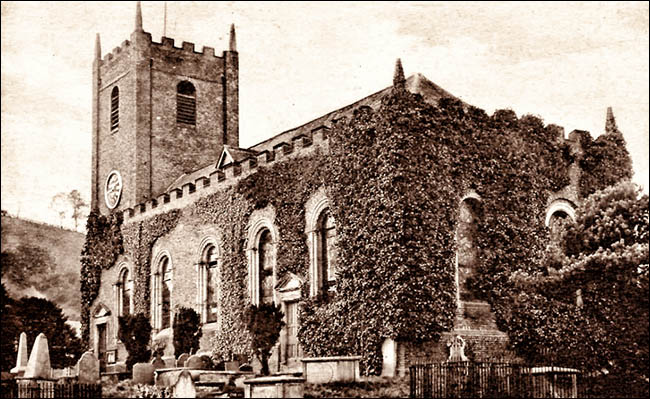St Myllin’s Church, Llanfyllin
Unusually for an historic Welsh church, St Myllin’s is built of brick. In the early 18th century, the local stone was believed to be too soft, so a brickworks was set up for the church’s construction. From then on, local bricks were favoured for many buildings in the district.
One Victorian vicar disliked the church’s brick walls so much that he planted ivy to cover the exterior, as shown in the old photo courtesy of Pauline Page-Jones. He also ordered many alterations to the interior.
 A church of Llanvelig in Llanfyllin is recorded in a 1254 document. St Myllin is said to have been a 7th-century Irish monk named Moling.
A church of Llanvelig in Llanfyllin is recorded in a 1254 document. St Myllin is said to have been a 7th-century Irish monk named Moling.
Inside the current church are boards listing the generosity of many people who donated to the church and relief for paupers. They also record that in 1704 Queen Anne granted permission for charitable fundraising for the new church. The church's six bells date from 1714.
The church was extended northwards in 1826 to provide a schoolroom. Mary Strangeways of Dorset and her mother Mary Vaughan provided almost £1,221 in total (over £110,000 in today’s money) to provide education for children from poor families, and to support poor widows and “decay’d Tenants”.
Another benefactor was Anne Wynn, who left £15 for the poor on her death in 1708, of which £10 was invested to bear interest to support “poor old women”. She had given silver salver for the church in 1700. The 1787 will of Evan Pryce left £200 for the rector and churchwarden to distribute the interest among the poor on named feast days, but “a failure of assets” halted the payments.
Dr Robert Wynne, chancellor of St Asaph diocese, gave £5 towards the church’s construction. Successive chancellors held court sessions in the church, usually to rule on morality. People found guilty of impropriety were whipped as they walked Llanfyllin’s streets. You can see some of the court’s furniture inside.
Railings in the churchyard surround the grave of rector William Williams and his great-grandson William Augeraud, whose great-grandfather Lieutenant Pierre Augeraud fell in love with Mary, the rector's daughter, while in Llanfyllin as a Napoleonic prisoner of war. Mary’s father forbade marriage. As a dying man, he arranged for Pierre's early return to France, but Pierre returned after the peace and the couple were married.
Postcode: SY22 5BL View Location Map


